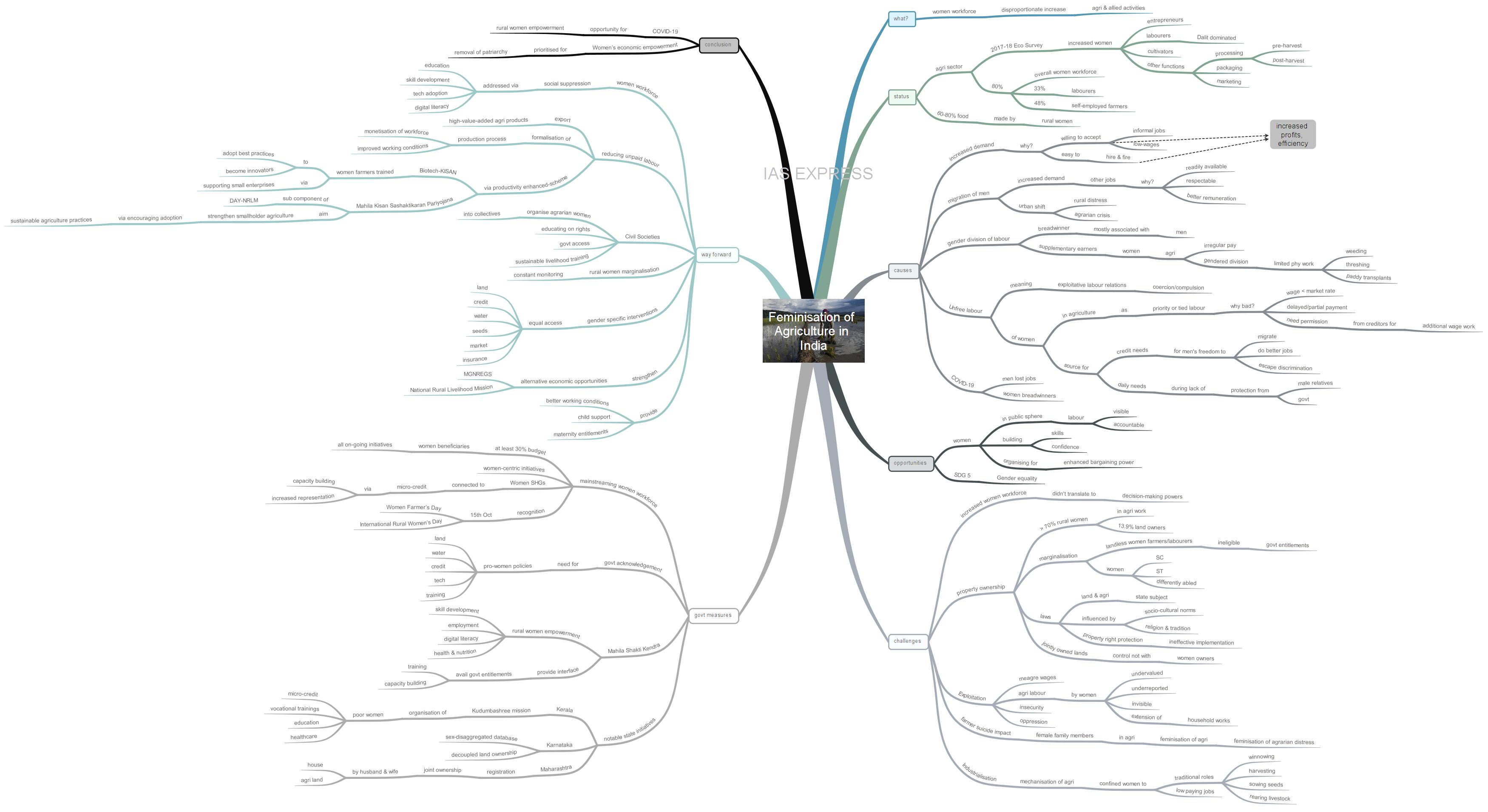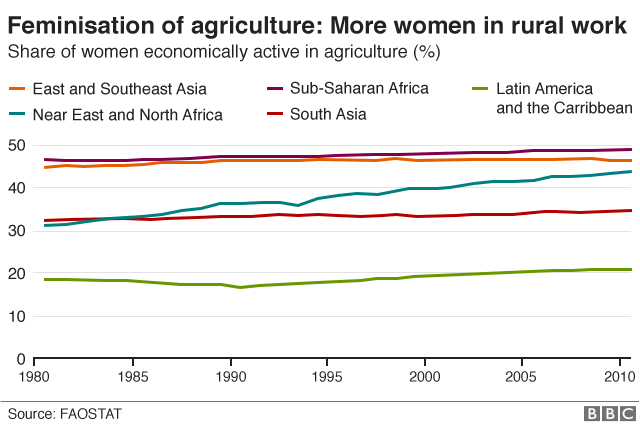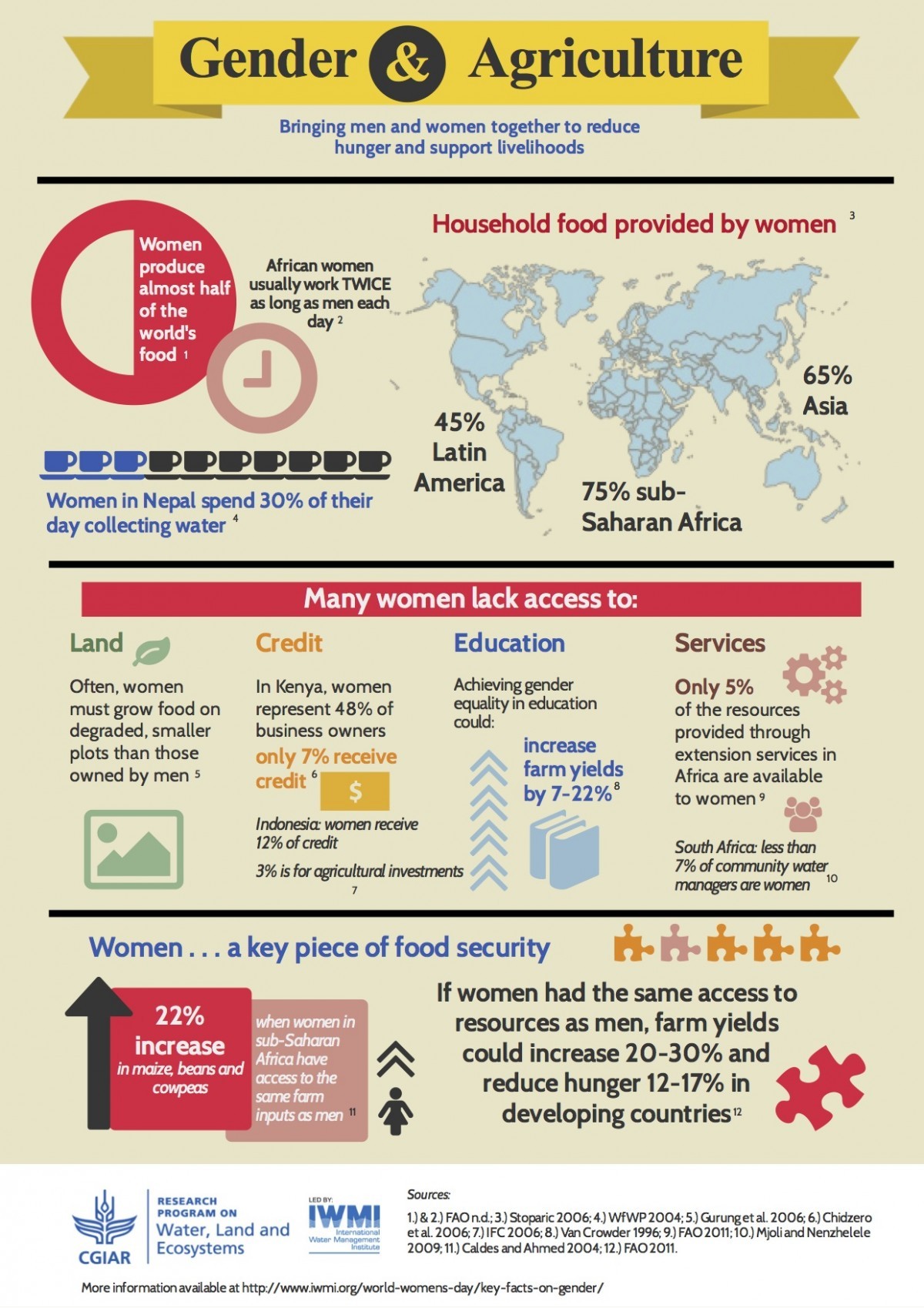Feminisation of Agriculture – Challenges and Way Ahead
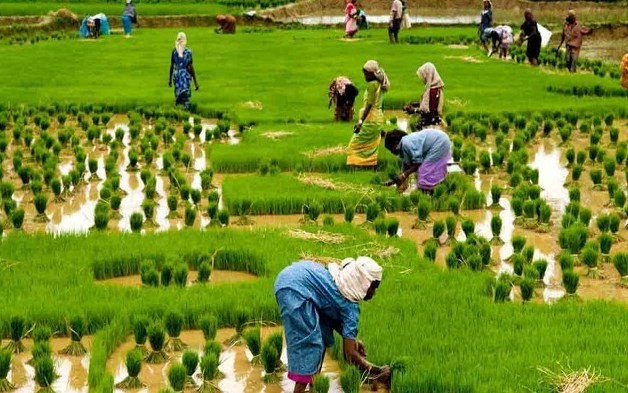
The pandemic-led health and socio-economic crisis have hit women and girls in a disproportionate fashion, leading to increased feminisation of poverty, domestic work, work burden as well as a spike in domestic violence. At the same time, it has also caused a boost in the feminisation of agriculture, making rural women play a critical role in providing household income. This presents an unmissable opportunity for the economic empowerment of women, which has the potential to remove all structural barriers hampering gender equality within India.
This topic of “Feminisation of Agriculture – Challenges and Way Ahead” is important from the perspective of the UPSC IAS Examination, which falls under General Studies Portion.
What is feminisation of agriculture sector?
- The term ‘feminisation of agriculture’ was first seen in the Economic Survey 2017-18.
- It is used to describe the increased absorption of women workforce in agricultural and allied activities.
- It points out the disproportionate concentration of women in the agriculture sector.
Is the Indian agriculture sector undergoing feminisation?
- According to the Economic Survey (2017-18), the agriculture sector is undergoing feminisation.
- Women, unlike men, have not migrated/shifted jobs during the agrarian crisis
- This has led them to increase their role in agriculture, mostly as entrepreneurs, labourers (Dalit women dominate this role) and cultivators.
- Their functions have diversified to include pre-harvest and post-harvest processing, packaging and marketing activities.
- The sector employs 80% of all women workforce in India, with 33% being agriculture labourers and 48% being self-employed farmers.
- Around 60-80% of food is produced by rural women.
What caused the feminisation of agriculture?
Demand:
- There is an increased demand for women workforce in this sector because they are considered to be more willing to accept low-wage informal jobs.
- This workforce is easier to hire and fire.
- These factors have enabled increased capital accumulation and cost-effective production within the sector.
Migration by men:
- With the rural distress and agrarian crisis plaguing the economy for the past several years, men in rural India have sought employment outside agriculture.
- They are opting to either shift to a non-farm sector or migrate to urban areas.
- These jobs include construction works, driving, teaching etc., which are socially perceived to be “male work”.
- They are readily available, respectable and provide better remuneration when compared to agricultural labour.
Gendered division of labour:
- Women’s participation in the rural, non-farm activities is very rare due to patriarchal socio-cultural norms.
- The concept of a “breadwinner” is strongly associated with men.
- This has forced women to concentrate on agricultural work as supplementary earners since such jobs provide irregular pays.
- Within the agricultural sector itself, there is a gendered division of labour.
- Some jobs like weeding, threshing and paddy transplants, requiring limited physical strength, are often associated with women.
- Doing works being considered as “man’s job” generally invite ridicules by society.
Unfree labour:
- Unfree labour is the term used to describe the types of exploitative labour relations, involving the use of coercion and compulsion to extract work from labourers.
- This problem is especially prevalent in labour-intensive works like agriculture, construction and several areas of manufacturing.
- The feminisation of agriculture is linked to women’s unfree labour, the consequence of which is the men’s freedom to migrate, engage in comparatively better jobs and escape social discrimination in the village.
- For instance, the initial credit for men to migrate to urban areas is sourced from women’s unfree labour involving priority or tied labour services to the creditor’s households.
- This means that the indebted women are forced to first work in the fields of their creditors during the peak agricultural season.
- Their wages are often lesser than the market rate, paid after a long delay or only paid partially.
- Often these women have to get permission from their creditors to take up additional agricultural wage work. This permission may be denied if there is a social, economic or political competition between the creditor’s household and those offering additional works.
- Unfree labour relations is also prevalent in cases where, due to the absence of state-driven social protection and male relatives, women are willingly dependent on creditors to meet their daily needs like health, education, food and farming expenses.
COVID-19 pandemic:
- Numerous women in rural India have taken charge of farming, playing a critical role in the food security of their households.
- They became ‘breadwinner’ of the households after men returned to the villages after losing jobs due to the pandemic.
What are the opportunities?
- The feminisation of agricultural sector brings women into the public sphere, makes their labour visible and accountable (though not always).
- It also creates potential in building the skills and confidence of women.
- It provides the opportunity for women to organise and enhance their bargaining power.
- Opportunity is also provided for achieving SDG 5 (gender equality).
What are the challenges?
Property ownership:
- Increase in women workforce in the agricultural sector did not translate into decision-making powers over vital issues like property and marriage.
- This is because they are included in the labour market under very adverse conditions.
- The 2017-18 NSSO data reveals that more than 70% of rural women are engaged in agricultural work.
- Yet, only 13.9% of women own land holdings, according to the agricultural census of 2015-16.
- This is despite their critical role in the cultivation process.
- This keeps landless women and female agricultural labourers on the fringes since insurance, credit, irrigation and other entitlements by government schemes are denied in the absence of land security.
- While land and agriculture are state subjects, laws governing them are influenced by religion, tradition and socio-cultural norms that go against women’s right to property.
- This apart, there is also the marginalisation of SC, ST and differently-abled women, who are side-lined on almost every aspect of their lives.
- Laws like the Forest Rights Act, which are meant to protect property rights of tribals, are inadequately implemented in some states, resulting in such marginalised communities living in poverty.
- In addition, merely granting joint ownership of lands does not necessarily mean that control of the property would be vested with women farmers.
Exploitation:
- Women are provided with little to no wages, as their work is often being considered as an extension of household work.
- Due to this situation, their labour is mostly undervalued, underreported and invisible.
- Such low-paying jobs and social constraints keep women confined in insecure and oppressive labour relations.
Impact of farmer suicides:
- The issue of farmer suicides lacks female perspective.
- The suicides by male cultivators caused the majority of female family members, especially the widows, to take up the responsibility of managing the household.
- Due to this reason, experts are deeming feminisation of agriculture as the feminisation of agrarian distress.
Industrialisation:
- The mechanisation of agriculture has led to the confinement of women to traditional, low-paying jobs like winnowing, harvesting, sowing seeds and rearing livestock.
What are the measures taken by the government?
- The government efforts to mainstream women workforce in the agriculture sector include:
- Allocating at least 30% budget for women beneficiaries in all on-going schemes, programmes and developmental activities
- Implementation of women-centric activities so that benefits reach them via various government programmes.
- Women SHGs are being connected to micro-credit through capacity building activities and increasing their representations in different decision-making processes
- Recognising the critical role women in agriculture by declaring 15th October as Women Farmer’s Day – the same date of International Rural Women’s Day
- The government has acknowledged the need for pro-women policies with respect to land, water, credit, technology and training – a step to ensure schemes focusing on these aspects.
- Mahila Shakti Kendra is one such government initiative aimed at empowering rural women with opportunities for skill development, employment, digital literacy, health and nutrition. The Mahila Shakti Kendras will work towards community engagement through student volunteers and provide an interface for rural women to approach the government to avail their entitlements through training and capacity building.
- Some of the state governments are already implementing various reforms and schemes to address issues faced by women in the sector:
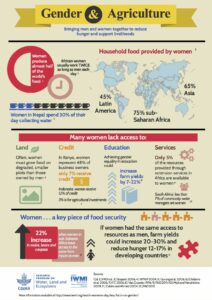
- Kudumbashree Mission, Kerala’s poverty eradication programme, is deemed to be the world’s largest women empowerment programme. It organises poor women at the grass-root level and enhances their socioeconomic standing through micro-credit and women empowerment initiatives like vocational training, education and healthcare.
- Karnataka has created a sex-disaggregated database on farmers and decoupled land ownership. This enables women farmers to have easier access to government-offered entitlements and schemes, as well as assistance and training.
- Maharashtra government has enabled joint ownership of house and agricultural land for husband and wife. Previously, only male household members were allowed to register as asset owners.
How can the feminisation of agriculture be utilised to empower women?
- The agriculture sector provides a much-needed opportunity for female economic empowerment.
- Yet, this potential remains unutilised due to various challenges.
- One of these issues is many women labourers work on family farms, where they cannot earn an independent income (or in many cases, any income at all).
- This issue can be addressed by promoting exports of high-value-added agricultural products, like seafood.
- The formalisation of the production process encourages the monetisation of the female workforce and improves their working conditions.
- Social norms shackling women workforce can be addressed via education, skill development, encouraging technological adoption and digital literacy.
- These can improve women workforce’s efficiency, profits, awareness, purchasing power etc.
- They will also enable the government to support these women through the dissemination of innovative technologies, techniques etc.
- Reducing unpaid labour in the agriculture sector is challenging.
- However, productivity-enhancing schemes can be implemented to overcome this challenge. The government is already executing several schemes in this regard:
- Biotech-KISAN: Mahila Biotech-KISAN fellowships train women farmers to adopt best practices in the agriculture sector, support them in their small enterprises and make them grass root innovators.
- Mahila Kisan Sashaktikaran Pariyojana is the sub-component of the Deendayal Antodaya Yojana-National Rural Livelihood Mission (DAY-NRLM). It seeks to strengthen smallholder agriculture through increased adoption of sustainable agriculture practices like Community Managed Sustainable Agriculture (CMSA), Non-Pesticide Management (NPM), Zero Budget Natural Farming, Pashu-Sakhi model for doorstep animal care services etc.
- Such policies and the effective use of innovative technologies can help utilise the opportunity provided by the increased female workforce participation in the agriculture sector.
- This in turn can address the issue of patriarchy within the society.
- Civil societies can play an important role in organising agrarian women into collectives, educating them of their rights, enabling access to the state and giving them sustainable livelihood training.
- It is also vital for consistently monitor the marginalisation of rural women engaged in agriculture via effective policy design.
- The phenomenon of defeminisation (exclusion of women from their entitlements in agriculture) can be addressed through:
- Strengthening of alternative economic opportunities for women through schemes like the Mahatma Gandhi National Rural Employment Guarantee Scheme and National Rural Livelihood Mission
- Gender-specific interventions to provide equal access to land, credit, water, seeds and market
- Providing better working conditions, child support, maternity entitlements etc.
Conclusion:
The COVID-19 crisis has provided an opportunity to address some of the long-standing societal issues, including the suppression of women. Economic empowerment of rural women must be prioritised in this current juncture, as this may ensure removal of patriarchal structures afflicting the country.
Practice question for mains:
Critically examine the challenges posed by the feminisation of agriculture in India. What are ways through which this opportunity can be utilised for the empowerment of women? (250 words)
https://pib.gov.in/Pressreleaseshare.aspx?PRID=1518099
https://www.downtoearth.org.in/news/agriculture/defeminisation-of-indian-agriculture-59834
https://www.devex.com/news/can-better-data-change-the-fate-of-india-s-invisible-female-farmers-96664
https://www.weforum.org/agenda/2020/07/farming-female-empowerment-agriculture-gender
https://vikaspedia.in/agriculture/policies-and-schemes/crops-related/biotech-kisan-scheme
https://vikaspedia.in/agriculture/women-and-agriculture/mahila-kisan-sashaktikaran-pariyojana
